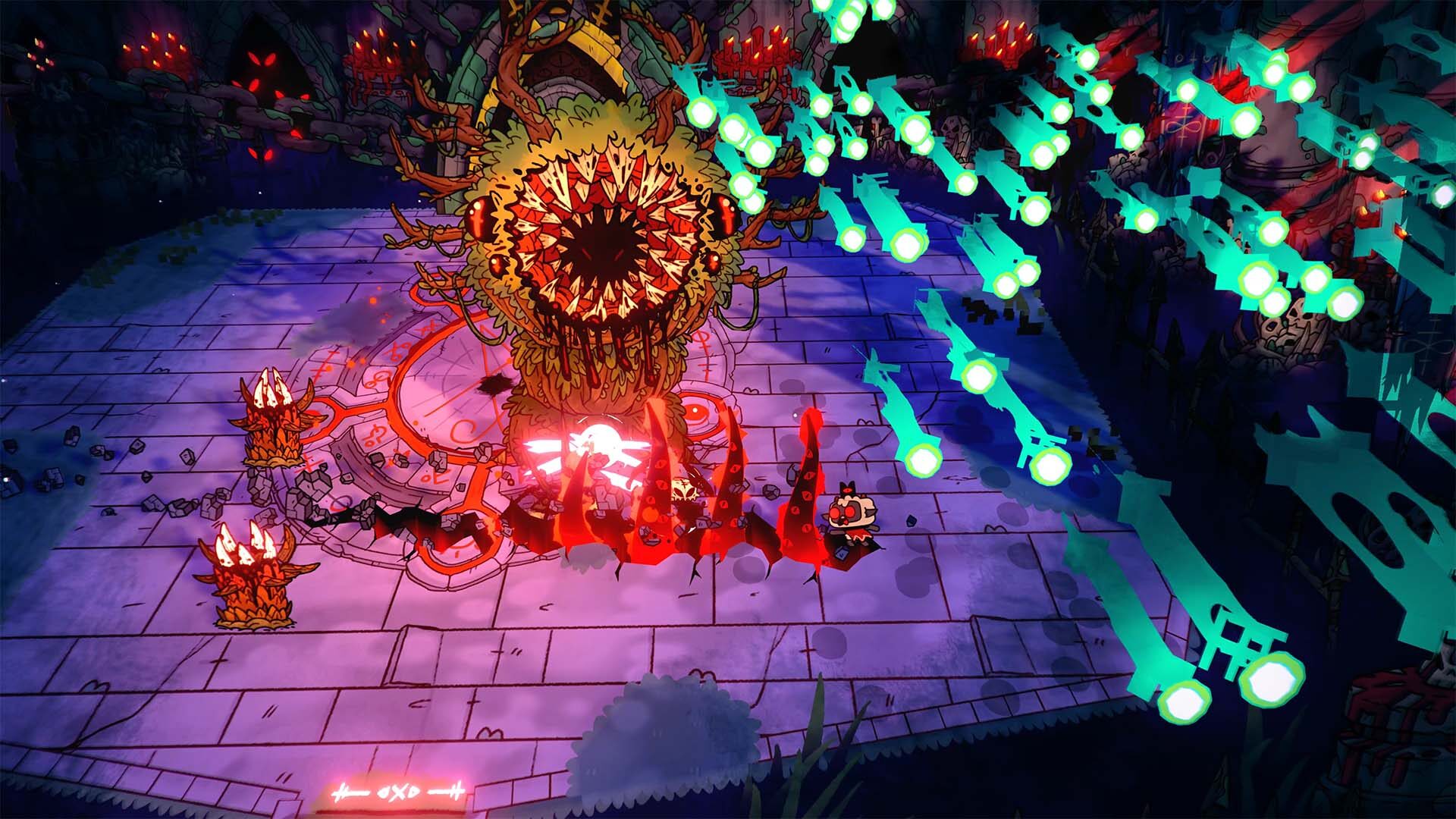Your hands are tied. There are candles everywhere. You try to walk away. Robed creatures stop you. You can only walk in one direction, towards a sacrificial circle. Monstrous figures stand over you and watch as the knife slides across your neck.
You die. Then you wake up. In a white room, The One Who Waits—a being with many arms and long teeth—tells you that you are now its disciple. In exchange for your life, you must now serve it. Gather followers. Build a community. And take revenge on those that killed you. There’s one other thing: That being is chained down for some reason. But you don’t really think about it, because you have no choice but to serve.
Also, you’re a little cartoon lamb with big eyes and bouncy wool and you’re just as cute as a button!
Cult of the Lamb leans heavily on the aesthetic of decorating a dark, disturbing story with cute and cuddly iconography. It’s the kind of irony that millennials who grew up on Conker’s Bad Fur Day, Newgrounds, and Happy Tree Friends are all too familiar with.
When I first started my demo of the game, I thought that this art style choice was too obvious to be effective. Cults are bad and scary. Cute cartoon animals are good and wholesome. The juxtaposition is the whole point, duh! But the longer I played it, the more I started to think that I was underestimating what Cult of the Lamb is doing.
In terms of actual design, Cult of the Lamb is a mashup of roguelikes and management sims. Half the time you, as the titular lamb, will hack and slash your way through the lands of the Old Faith to slaughter heretics, recruit new followers, and gather resources like bones and coins. Eventually, you will kill the leader of that region, one of the priests of the Old Faith, when you become strong enough.

To do that, you must engage with the other half of Cult of the Lamb, which is managing your cult. Here, you will assign your followers—other cute animals that you rescued from being sacrificed just as you were—tasks such as chopping down trees and mining rocks and, most importantly, praying at your altar. While you need resources like berries, wood, and stone to build facilities that will keep your followers happy and safe, you need their Devotion to actually upgrade your abilities and unlock new weapons and curses (special attacks).
While the cynical might just call this a roguelike with extra steps, Cult of the Lamb’s management sim half gives a healthy dose of context and, miraculously, ended up being my favorite part of the game. The combat is fun enough, though it feels pretty standard at this point in a post-Isaac and post-Hades world. But it definitely wouldn’t have held my interest if I didn’t know that I was fighting for resources that my cult desperately needed. The two halves of Cult of the Lamb are as synergistic as peanut butter and jelly. I did run into a few bugs, like one that temporarily deleted my temple, but they were pretty easily remedied by simply quitting out and rebooting the game.
Weirdly enough, I never clicked with Moonlighter, another game that combines roguelike combat with management sim duties, mostly because I didn’t really understand who I was fighting for. But for some reason, I instantly cared about making sure my cult followers had the best living arrangements possible. I wanted my followers to be happy, not just because I needed their Devotion, but because I didn’t want to be one of those evil cult leaders. If we’re drinking any Kool-Aid, it will be completely cyanide free, thank you very much.
And that’s when I realized why Cult of the Lamb’s art style was so effective. It wasn’t in service of detached irony, but an incredibly effective tool for getting me immediately invested in the tiny lives of my adorable cult members. Call it the Animal Crossing Effect.

By the time I killed one of the priests of the Old Faith and ended my demo, I was feeling optimistic about the future of my cult. We had enough food and shelter for everyone, and their Devotion was through the roof. But there were already hints that my darling followers were going to cause me heartache if I kept playing. One of them—a tiny deer who I had gifted a necklace to celebrate his loyalty—told me that another was actually a spy, a traitor to our faith. But was he telling the truth or trying to throw me off the scent? I built a farm, a temple, shelters, and a logging camp. But I also noticed more disturbing options for structures like prisons or body pits.
I shudder at the thought of having to one day utilize these kinds of facilities. But if there must be a culling to protect the flock, then a culling we shall have. And when the worst happens, I have faith that my followers will understand.
Cult of the Lamb launches on August 11th for Xbox Series X/S, PlayStation 5, Nintendo Switch, Xbox One, PlayStation 4, and PC.
Images: Devolver Digital

Michael Goroff has written and edited for EGM since 2017. You can follow him on Twitter @gogogoroff.